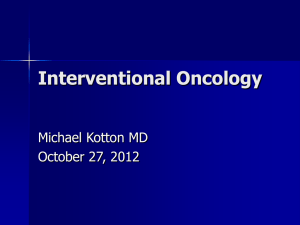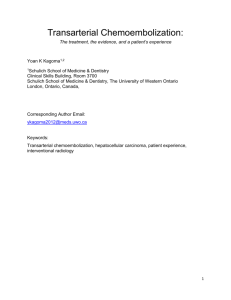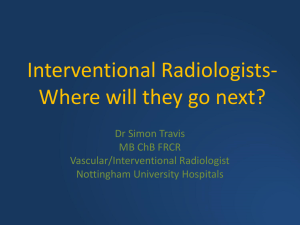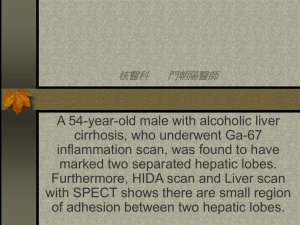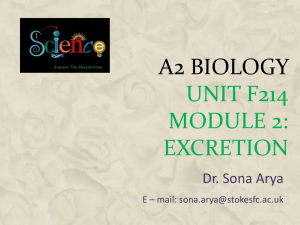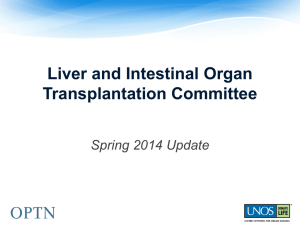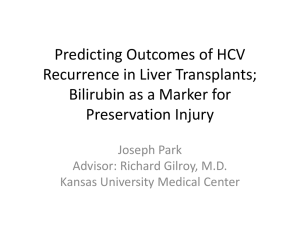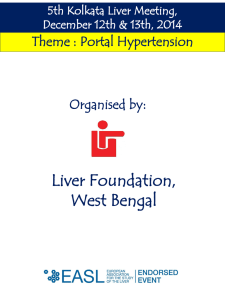HCC
advertisement
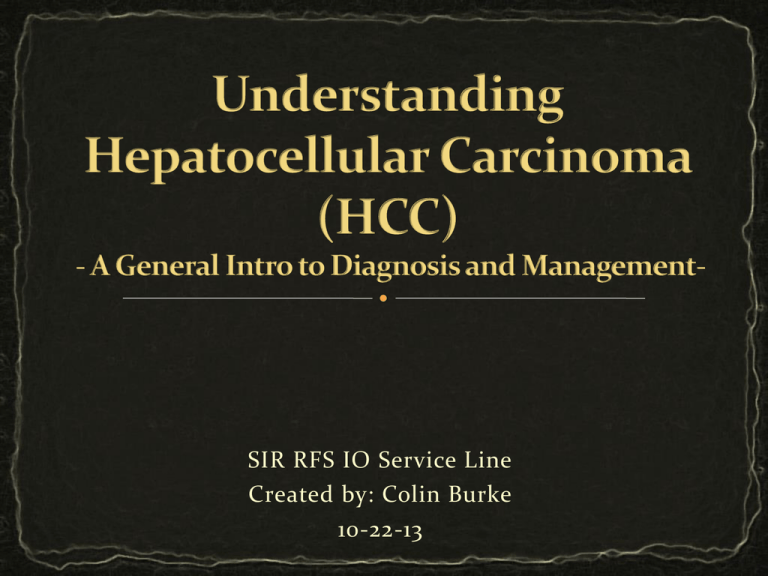
SIR RFS IO Service Line Created by: Colin Burke 10-22-13 Images from: Vascular and Biliary Variants in the Liver: Implications for Liver Surgery: Radiographics March-April 2008 28:2 359-378 2 www.deltagen.com www.wikipedia.org 3 5th most common cancer Fastest growing cause of cancer mortality Risk Factors HBV HCV Cirrhosis Alcoholism Biliary cirrhosis Hemochromatosis NAFLD Aflatoxins- Esp. in Asian population 4 Multifactorial, exact mechanism unclear Inflammation, necrosis, fibrosis, regeneration of cirrhotic liver Environmental toxins Mistakes in regenerative pathway Gene mutations: p53, B catenin Main Theory Repeated necrosis & www.livingwithcancerinternational.com regeneration + genetic material in viral hepatitis = mutations & abnormal cell proliferation 5 Jaundice, pruritis Ascites, Abdominal Pain Variceal bleed Encephalopathy Paraneoplastic syndromes Unintentional weight loss Image from: http://www.mcemcourses.org/wpcontent/uploads/case9picture.jpg 6 Chronic Liver Disease: Screen with US every 6 months AASLD Guidelines Asian men over 40 & Asian woman over 50 Patients with HBV & Cirrhosis African & North American Blacks Patients with a family history of HCC US results Nodule < 1 cm Usually not HCC, monitor every 3 months until they disappear Nodules > 1 cm Evaluate with CT/MRI Biopsy only if unable to diagnose on imaging findings Lab Studies Nonspecific: Anemia, thrombocytopenia, increased LFTs, AFP Raises concern, especially when over 200 mg/dl 7 US Small hypo-echoic lesion Heterogenous (fibrosis, fatty change & calcifications) Hard to distinguish from cirrhosis 8 CT Focal, multifocal diffuse, infiltrative or atypical Hypervascularity in arterial phase, washout in portal and delayed phases Focal necrosis and calcification (10%) Capsule (24%) 9 10 MRI T1 Variable Isointense or hyperintense compared to surrounding liver T2 Variable, typically hyperintense Post-gadolinium Arterial-phase enhancement +/- discrete feeder vessels 11 Unresectable: mortality within 3-6 months Resectable: partial hepatectomy curative due to regenerative nature of liver 2/3 of the liver can be resected Role of portal vein embolization prior to partial hepactectomy IR embolizes the right portal vein, stimulating hypertrophy of noninvolved lobe & can qualify the patient for resection or bridging to Tx 5 year survival if resectable: 37-56% Only 10-20% are completely resectable 12 Medical Therapy Minimally responsive to chemotherapy Sorafenib (tyr-kinase inhib) used for advanced cases Mainly Palliative Lactulose titrated to 2-3 loose stools/day to control encephalopathy in cirrhosis. Diuretics to control ascites Antibiotic prophylaxis to prevent SBP Surgical Therapy Liver transplant Resection Small lesions may be cured under RFA done by IR http://www.ppdictionary.com/viruses/carcinoma_hepatitis_ b.jpg 13 Unresectable tumors Increase survival, improve quality of life, currently not intended for cure Slows progression and is palliative. Also used to help patient’s survive partial hepatectomy or act as a bridge to transplant. Terminology Transarterial Chemoembolization: TACE Radiofrequency Ablation: RFA Selective Internal Radiation Therapy: SIRT Portal Vein Embolization: PVE http://www.anes.ucla.edu/images/news/large/DSC02293.jpg 14 Percutaneous transhepatic approach Embolization of portal vein supplying lobe of liver with the tumor Compensatory hypertrophy of surviving lobe can qualify patient for resection Patients initially unresectable due to insufficient remaining normal parenchyma may qualify Post resection morbidity decreased Right PVE: http://radiographics.rsna.org/content/22/5/1063/F13. expansion.html Serve as a bridge to transplant 15 Selective injection of antineoplastic agent with a radiopaque contrast agent (lipiodol) and embolic agent (gelfoam) Higher dose of chemotherapy due to decreased systemic exposure Post Procedure Post Embolization Syndrome Hospital stay of 1-3 days Decreased energy in the following 2 months Abominal Pain, transaminitis Follow up CT several weeks later to check for tumor response Repeat TACE Only 2% of patients have complete response from 1 procedure Considered non-curative (unlike RFA) Base repeat treatment on tumor response and hepatic reserve 16 Destroys tumor using thermal energy from high frequency radio waves Usually used for small tumors (< 3cm) US guided percutaneous approach Post Procedure Follow up CT/MRI several weeks later to check for tumor response. Can also follow AFP 17 Similar to chemoembolization Uses radioactive microspheres Radioactive isotope Yttrium (Y-90) incorporated into radioactive spheres Spheres selectively injected and get lodged in tumor capillaries and proximal vascular supply Localized brachytherapy Combined radiation and ischemia results in cell death. Post Procedure Post embolization syndrome with fatigue, constitutional symptoms, and abdominal pain Follow up CT/MRI several weeks later to check tumor response. Can also follow AFP. Return to IR if AFP remains increased. Monitor for variceal bleeds and assessment of underlying liver function. http://www.rwjuh.edu/images/cancer/sirt image2.jpg 18 TACE Post Embolization Syndrome Liver Failure Post Embolization Syndrome 20-55% Hepatic Dysfunction RFA 3-5% Non target embolization into left gastric SIRT Dependent on preprocedure liver function 20% of patients, irreversible in 6% Gastroduoenal ulceration 60-80% of patients Fatigue, constitutional symptoms, abdominal pain Symptoms last 3-4 days, full recovery in 7-10 Complications are rare but include abscess formation, subcapsular hematoma and tract seeding If HCC is not treated TNM staging: 5 year survival 55%, 37% and 16% for stage I, II, III respectively Okuda system: tumor size and degree of cirrhosis 8.3, 2.0 and 0.7 months for stage I, II, and III respectively 19 HCC: Relatively poor prognosis including both high morbidity and mortality Main risk factors are chronic liver disease such as HBV, HCV, and cirrhosis Patients often present with decompensation of chronic liver disease Medical management generally palliative, aimed at reducing liver disease symptoms, chemotherapy is traditionally ineffective Surgical resection and transplant can be curative 20 Screen high risk patients with US, f/u with CT/MRI IR procedures traditionally palliative for unresectable tumors and those patients who are not yet candidates for liver transplant Growing evidence suggesting increased role for IO therapies Smaller (<4cm) or solitary lesions managed with RFA Large or multifocal tumors = TACE or SIRT Insufficient data for combination RFA and TACE Efficacy (complicated and conflicting data) TACE: Objective response: 6-60%. Most studies show increased survival vs conservative treatment SIRT: Comparable to TACE RFA: can be curative. 80-90% response for tumors<3 cm Common complications: Post embolization syndrome and hepatic dysfunction www.barrieronline.com 21 Catalano OA, Singh AH, Uppot RN, Hahn PF, Ferrone CR, Sahani DV.Vascular and Biliary Variants in the Liver: Implications for Liver Surgery: Radiographics March-April 2008 28:2 359-378 Furuta T, Maeda E, Akai H, Hanaoka S, Yoshioka N, Akahane M, Watadani T, Ohtomo K.. Hepatic Segments and Vasculature: Projecting CT Anatomy onto Angiograms. Radiographics. November 2009 Nov;29(7):1-22. Madoff DC, Hicks ME, Vauthey JN, Charnsangavej C, Morello FA Jr, Ahrar K, Wallace MJ, Gupta S. Transhepatic portal vein embolization: anatomy, indications, and technical considerations. Radiographics. 2002 Sep-Oct;22(5):1063-76 Yang ZF, Poon RT. Vascular changes in hepatocellular carcinoma. Anat Rec (Hoboken). 2008 Jun;291(6):721-34 Roche SP, Kobos R. Jaundice in the adult patient. Am Fam Physician. 2004 Jan 15;69(2):299-304 Uptodate Clinical features and diagnosis of primary hepatocellular carcinoma. http://www.uptodate.com/contents/clinical-features-anddiagnosis-of-primary-hepatocellular-carcinoma?source=see_link. Last Updated Sept 23, 2013. Accessed October 20th 2013. Epidemiology and etiologic associations of hepatocellular carcinoma http://www.uptodate.com/contents/epidemiology-and-etiologicassociations-of-hepatocellular-carcinoma?source=see_link. Last Updated August 30 2013. Accessed October 21, 2013 Prevention of hepatocellular carcinoma and recommendations for surveillance in adults with chronic liver disease. http://www.uptodate.com/contents/prevention-of-hepatocellular-carcinoma-and-recommendations-for-surveillance-in-adults-withchronic-liver-disease?source=see_link. Last Updated July 12, 2013. Accessed October 20, 2013 Surgical management of potentially resectable hepatocellular carcinoma. http://www.uptodate.com/contents/surgical-managementof-potentially-resectable-hepatocellular-carcinoma?source=preview&anchor=H1061867819&selectedTitle=2~150#H1061867819 . Last Updated May 22, 2013. Accessed October 23, 2013 Nonsurgical therapies for localized hepatocellular carcinoma: Transarterial embolization, radiotherapy, and radioembolization http://www.uptodate.com/contents/nonsurgical-therapies-for-localized-hepatocellular-carcinoma-transarterial-embolizationradiotherapy-and-radioembolization?source=preview&anchor=H1248650314&selectedTitle=1~16#H1248650342 . Last Updated Sept 6 2013. Accessed October 23,2013 Inteventional Radiology Treatments for Liver Cancer. http://www.sirweb.org/patients/liver-cancer/. Accessed October 2014 Anatomy of Liver Segments. http://www.radiologyassistant.nl/en/p4375bb8dc241d/anatomy-of-the-liver-segments.html Accessed October 2013 22 Image addapted from: http://www.utmb.edu/surgicalpathology/picts/photo_of_the_month_2006_2007/pom_aug_06.jpg 23



